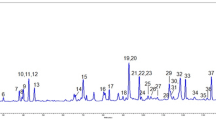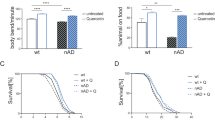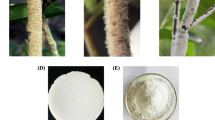Abstract
Substantial evidence suggests that the aggregation of amyloid-β (Aβ) peptide into fibrillar structures that is rich in β-sheets is implicated as the cause of Alzheimer’s disease. Therefore, an attractive therapeutic strategy is to prevent or alter Aβ aggregation. Phenolic compounds are natural substances that are composed of one or more aromatic phenolic rings and present in wine, tea, fruits, vegetables and a wide variety of plants. In this work, we investigated the effects of ferulic acid, morin, quercetin and gossypol against Aβ aggregation. From the ThT and turbidity assays, it is observed that in addition to the fibril aggregate, another type of aggregate is formed in the presence of morin, quercetin, and gossypol. On the other hand, ferulic acid did not prevent fibril formation, but it did appear to reduce the average length of fibrils compared to Aβ alone. To study the protective effects of phenolic compounds on Aβ-induced toxicity, we utilized the nematode Caenorhabditis elegans (C. elegans) as an in vivo model organism, human Aβ is expressed intracellularly in the body wall muscle. We found that exposure of Caenorhabditis elegans to ferulic acid give more protection against Aβ toxicity than morin, quercetin and gossypol.





Similar content being viewed by others
References
Goedert M, Spillantini MG (2006) A century of Alzheimer’s disease. Science 314:777–781
Hardy J (2006) A hundred years of Alzheimer’s disease research. Neuron 52:3–13
Selkoe DJ (2006) The ups and downs of Abeta. Nat Med 12:758–759
Zhang YW, Xu H (2007) Molecular and cellular mechanisms for Alzheimer’s disease: understanding APP metabolism. Curr Mol Med 7:687–696
Wolfe MS, Guénette SY (2007) APP at a glance. J Cell Sci 120:3157–3161
Serretti A, Olgiati P, De Ronchi D (2007) Genetics of Alzheimer’s disease. A rapidly evolving field. J Alzheimers Dis 12:73–92
Ertekin-Taner N (2007) Genetics of Alzheimer’s disease: a centennial review. Neurol Clin 25:611–667
Kowall NW, Beal MF, Busciglio J, Duffy LK, Yankner BA (1991) An in vivo model for the neurodegenerative effects of beta amyloid and protection by substance P. Proc Natl Acad Sci USA 88:7247–7251
Pike CJ, Walencewicz AJ, Glabe CG, Cotman CW (1991) Aggregation-related toxicity of synthetic beta-amyloid protein in hippocampal cultures. Eur J Pharmacol 207:367–368
Pereira C, Agostinho P, Moreira PI, Cardoso SM, Oliveira CR (2005) Alzheimer’s disease-associated neurotoxic mechanisms and neuroprotective strategies. Curr Drug Targets CNS Neurol Disord 4:383–403
Glabe CG (2006) Common mechanisms of amyloid oligomer pathogenesis in degenerative disease. Neurobiol Aging 27:570–575
Thapa A, Woo ER, Chi EY, Sharoar MG, Jin HG, Shin SY, Park IS (2011) Biflavonoids are superior to monoflavonoids in inhibiting amyloid-β toxicity and fibrillogenesis via accumulation of nontoxic oligomer-like structures. Biochemistry 50:2445–2455
Ferreira ST, Vieira MN, De Felice FG (2007) Soluble protein oligomers as emerging toxins in Alzheimer’s and other amyloid diseases. IUBMB Life 59:332–345
Walsh DM, Selkoe DJ (2007) Abeta oligomers—a decade of discovery. J Neurochem 101:1172–1184
Hubbard GP, Wolffram S, Lovegrove JA, Gibbins JM (2003) The role of polyphenolic compounds in the diet as inhibitors of platelet function. Proc Nutr Soc 62:469
St-Laurent-Thibault C, Arseneault M, Longpré F, Ramassamy C (2011) Tyrosol and hydroxytyrosol, two main components of olive oil, protect N2a cells against amyloid-β-induced toxicity. Involvement of the NF-κB signaling. Curr Alzheimer Res 8:543–551
Scalbert A, Manach C, Mrand C, Remesy C, Jimenez L (2005) Dietary polyphenols and the prevention of diseases. Crit Rev Food Sci Nutr 45:287
Manach C, Scalbert A, Morand C, Remesy C, Jimenez L (2004) Polyphenols: food sources and bioavailability. Am J Clin Nutr 79:727
Murray NJ, Williamson MP, Lilley TH, Haslam E (1994) Study of the interaction between salivary proline-rich proteins and a polyphenol by 1H-NMR spectroscopy. Eur J Biochem 219:923–935
Richard T, Verge S, Berke B, Vercauteren J, Monti JP (2001) NMR and simulated annealing investigations of bradykinin in presence of polyphenols. J Biomol Struct Dyn 18:627
Charlton AJ, Baxter NJ, Khan ML, Moir AJ, Haslam E, Davies AP, Williamson MP (2002) Polyphenol/peptide binding and precipitation. J Agric Food Chem 50:1593–1601
Verge S, Richard T, Moreau S, Nurich A, Merillon JM, Vercauteren J, Monti JP (2002) First observation of solution structures of bradykinin-penta-O-galloyl-D-glucopyranose complexes as determined by NMR and simulated annealing. Biochim Biophys Acta 1571:89–101
Richard T, Vitrac X, Merillon JM, Monti JP (2005) Role of peptide primary sequence in polyphenol-protein recognition: an example with neurotensin. Biochim Biophys Acta 1726:238–243
Lashuel HA, Hartley DM, Balakhaneh D, Aggarwal A, Teichberg S, Callaway DJ (2002) New class of inhibitors of amyloid-beta fibril formation. Implications for the mechanism of pathogenesis in Alzheimer’s disease. J Biol Chem 277:42881–44290
Savaskan E, Olivieri G, Meier F, Seifritz E, Wirz-Justice A, Muller-Spahn F (2003) Red wine ingredient resveratrol protects from beta-amyloid neurotoxicity. Gerontology 49:380–383
Lancon A, Delma D, Osman H, Thenot JP, Jannin B, Latruffe N (2004) Human hepatic cell uptake of resveratrol: involvement of both passive diffusion and carrier-mediated process. Biochem Biophys Res Commun 316:1132–1137
Ono K, Hasegawa K, Naiki H, Yamada M (2004) Anti-amyloidogenic activity of tannic acid and its activity to destabilize Alzheimer’s beta-amyloid fibrils in vitro. Biochim Biophys Acta 1690:193–202
Ono K, Hasegawa K, Naiki H, Yamada M (2004) Curcumin has potent anti-amyloidogenic effects for Alzheimer’s beta-amyloid fibrils in vitro. J Neurosci Res 75:742–750
Ono K, Yoshiike Y, Takashima A, Hasegawa K, Naiki H, Yamada M (2003) Potent anti-amyloidogenic and fibril-destabilizing effects of polyphenols in vitro: implications for the prevention and therapeutics of Alzheimer’s disease. J Neurochem 87:172–181
Yang F, Lim GP, Begum AN, Ubeda OJ, Simmons MR, Ambegaokar SS, Chen PP, Kayed R, Glabe CG, Frautzchy SA, Cole GM (2005) Curcumin inhibits formation of amyloid β oligomers and fibrils, binds plaques, and reduces amyloid in vivo. J Biol Chem 280:5892–5901
Durairajan SS, Yuan Q, Xie L, Chan WS, Kum WF, Koo I, Liu C, Song Y, Huang JD, Klein WL, Li M (2008) Salvianolic acid B inhibits Abeta fibril formation and disaggregates preformed fibrils and protects against Abeta-induced cytotoxicty. Neurochem Int 52:741–750
Rivière C, Richard T, Vitrac X, Mérillon JM, Valls J, Monti JP (2008) New polyphenols active on beta-amyloid aggregation. Bioorg Med Chem Lett 18:828–831
Feng Y, Wang XP, Yang SG, Wang YJ, Zhang X, Du XT, Sun XX, Zhao M, Huang L, Liu RT (2009) Resveratrol inhibits beta-amyloid oligomeric cytotoxicity but does not prevent oligomer formation. Neurotoxicology 30:986–995
Ono K, Condron MM, Ho L, Wang J, Zhao W, Pasinetti GM, Teplow DB (2008) Effects of grape seed-derived polyphenols on amyloid beta-protein self-assembly and cytotoxicity. J Biol Chem 283:32176–32187
Muthaiyah B, Essa MM, Chauhan V, Chauhan A (2011) Protective Effects of walnut extract against amyloid beta peptide-induced cell death and oxidative stress in PC12 cells. Neurochem Res. doi:10.1007/s11064-011-0533-z
Henry-Vitrac C, Berbillen H, Mérillon J, Vitrac X (2010) Soy isoflavones as potential inhibitors of Alzheimer ß-amyloid fibril aggregation in vitro. Food Res Int 43:2176–2178
Conte A, Pellegrini S, Tagliazucchi D (2003) Synergistic protection of PC12 cells from beta-amyloid toxicity by resveratrol and catechin. Brain Res Bull 62:29–38
Nakagami Y, Nishimura S, Murasugi T, Kaneko I, Meguro M, Marumoto S, Kogen H, Koyama K, Oda T (2002) A novel beta-sheet breaker, RS-0406, reverses amyloid beta-induced cytotoxicity and impairment of long-term potentiation in vitro. Br J Pharmacol 137:676–682
Bastianetto S, Quirion R (2002) Natural extracts as possible protective agents of brain aging. Neurobiol Aging 23:891–897
Bastianetto S, Quirion R (2004) Natural antioxidants and neurodegenerative diseases. Front Biosci 9:3447–3452
Bate C, Salmona M, Williams A (2004) Ginkgolide B inhibits the neurotoxicity of prions or amyloid-beta1–42. J Neuroinflammation 1:4
Romero I, Páez A, Ferruelo A, Luján M, Berenguer A (2002) Polyphenols in red wine inhibit the proliferation and induce apoptosis of LNCaP cells. BJU Int 89:950–954
García Mediero JM, Ferruelo Alonso A, Páez Borda A, Luján Galán M, Angulo Cuesta J, Chiva Robles V, Berenguer Sánchez A (2005) Effect of polyphenols from the Mediterranean diet on proliferation and mediators of in vitro invasiveness of the MB-49 murine bladder cancer cell line. Actas Urol Esp 29:743–749
Kim H, Park BS, Lee KG, Choi CY, Jang SS, Kim YH, Lee SE (2005) Effects of naturally occurring compounds on fibril formation and oxidative stress of beta-amyloid. J Agric Food Chem 53:8537–8541
Ono K, Hirohata M, Yamada M (2005) Ferulic acid destabilizes preformed beta-amyloid fibrils in vitro. Biochem Biophys Res Commun 336:444–449
Ono K, Yamada M (2006) Antioxidant compounds have potent anti-fibrillogenic and fibril-destabilizing effects for alpha-synuclein fibrils in vitro. J Neurochem 97:105–115
Fujita A, Sasaki H, Doi A, Okamoto K, Matsuno S, Furuta H, Nishi M, Nakao T, Tsuno T, Taniguchi H, Nanjo K (2008) Ferulic acid prevents pathological and functional abnormalities of the kidney in Otsuka Long-Evans Tokushima fatty diabetic rats. Diabetes Res Clin Pract 79:11–17
Ardiansyah OhsakiY, Shirakawa H, Koseki T, Komai M (2008) Novel effects of a single administration of ferulic acid on the regulation of blood pressure and the hepatic lipid metabolic profile in stroke-prone spontaneously hypertensive rats. J Agric Food Chem 56:2825–2830
Moons DO, Kim MO, Lee JD, Kim GY (2008) Gossypol suppresses NF-kappaB activity and NF-kappaB-related gene expression in human leukemia U937 cells. Cancer Lett 264:192–200
Link CD (1995) Expression of human beta-amyloid peptide in transgenic Caenorhabditis elegans. Proc Natl Acad Sci USA 92:9368–9372
Wu Y, Luo Y (2005) Transgenic C. Elegans as a model in Alzheimer’s research. Curr Alzheimer Res 2:37–45
Fields GB, Noble RL (1990) Solid phase peptide synthesis utilizing 9-fluorenylmethoxycarbonyl amino acids. Int J Pept Protein Res 35:161–214
Chan WC, White PD (2000) F-moc solid phase peptide synthesis, a practical approach. Oxford University Press Inc, New York
Kaiser E, Colescott RL, Bossinger CD, Cook PI (1970) Color test for detection of free terminal amino groups in the solid-phase synthesis of peptides. Anal Biochem 34:595–598
Chen S, Wetzel R (2001) Solubilization and disaggregation of polyglutamine peptides. Protein Sci 10:887–891
Naiki H, Higuchi K, Hosokawa M, Takeda T (1989) Fluorometric determination of amyloid fibrils in vitro using the fluorescent dye, thioflavin T1. Anal Biochem 177:244–249
LeVine H (1999) Quantification of beta-sheet amyloid fibril structures with thioflavin T. Methods Enzymol 309:274–284
Lewis JA, Fleming JT (1996) In: Epstein HF, Shakes DC (eds) Caenorhabditis elegans: modern biological analysis of a model organism. Academic Press, New York, pp 3–29
Hensley K, Carney JM, Matson MP, Aksenova M, Harris M, Wu JF, Floyd RA, Butterfield DA (1994) A model for beta-amyloid aggregation and neurotoxicity based on free radicle generation by the peptide: relevance to Alzheimer disease. Proc Natl Acad Sci USA 91:3270–3274
Behl C, Davis JB, Klier FG, Schubert D (1994) Amyloid beta peptide induces necrosis rather than apoptosis. Brain Res 645:253–264
Harris ME, Hensley K, Butterfield DA, Leedle RA, Carney JM (1995) Direct evidence of oxidative injury produced by the Alzheimer’s beta-amyloid peptide (1–40) in cultured hippocampal neurons. Exp Neurol 131:193–202
Kanski J, Aksenova M, Butterfield DA (2002) The hydrophobic environment of Met35 of Alzheimer’s Aβ (1–42) is important for the neurotoxic and oxidative properties of the peptide. Neurotox Res 4:219–223
Kanski J, Aksenova M, Schoneich C, Butterfield DA (2002) Substitution of isoleucine-31 by helical-breaking proline abolishes oxidative stress and neurotoxic properties of Alzheimer’s amyloid beta-peptide (1–42). Free Radic Biol Med 32:1205–1211
Mark RJ, Lovell MA, Markesbery WR, Uchida K, Mattson MP (1997) A role for 4-hydroxynonenal, an aldehydic product of lipid peroxidation, in disruption of ion homeostasis and neuronal death induced by amyloid beta-peptide. J Neurochem 68:255–264
Varadarajan S, Kanski J, Aksenova M, Lauderback C, Butterfield DA (2001) Different mechanisms of oxidative stress and neurotoxicity for Alzheimer’s A beta (1–42) and A beta (25–35). J Am Chem Soc 123:5625–5631
Kim DS, Park SY, Kim JY (2001) Curcuminoids from Curcumalonga L. (Zingiberaceae) that protect PC12 rat pheochromocytoma and normal human umbilical vein endothelial cells from βA (1–42) insult. Neurosci Lett 303:57–61
Park YS, Kim DS (2002) Discovery of natural products from Curcuma longa that protect cells from beta-amyloid insult: A drug discovery effort against Alzheimer’s disease. J Nat Prod 65:1227–1231
Howes MJ, Perry NS, Houghton PJ (2003) Plants with traditional uses and activities, relevant to the management of Alzheimer’s disease and other cognitive disorders. Phytother Res 17:1–18
Ono K, Naiki H, Yamada M (2006) The development of preventives and therapeutics for Alzheimer’s disease that inhibit the formation of beta-amyloid fibrils (fAbeta), as well as destabilize preformed fAbeta. Curr Pharm Des 12:4357–4375
Porat Y, Abramowitz A, Gazit E (2006) Inhibition of amyloid fibril formation by polyphenols: structural similarity and aromatic interactions as a common inhibition mechanism. Chem Biol Drug Des 67:27–37
McLaurin J, Kierstead ME, Brown ME, Hawkes CA, Lambermon MHL, Phinney AL, Darabie AA, Cousins JE, French JE, Lan MF, Chen F, Wong SSN, Mount HTJ, Fraser PE, Westaway D, PSt George-Hyslop (2006) Cyclohexanehexol inhibitors of Aβ aggregation prevent and reverse Alzheimer. Nat Med 12:801–808
Hirohata M, Hasegawa K, Tsutsumi-Yasuhara S, Ohhashi Y, Ookoshi T, Ono K, Yamada M, Naiki H (2007) The anti-amyloidogenic effect is exerted against Alzheimer’s β-amyloid fibrils in vitro by preferential and reversible binding of flavonoids to the amyloid fibril structure. Biochemistry 46:1888–1899
Krebs MRH, Bromley EHC, Donald AM (2005) The binding of thioflavin-T to amyloid fibrils: localization and implications. J Struct Biol 149:30–37
Kim HS, Cho JY, Kim DH, Yan JJ, Lee HK, Suh HW, Song DK (2004) Inhibitory effects of long-term administration of ferulic acid on microglial activation induced by intracerebroventricular injection of beta-amyloid peptide (1–42) in mice. Biol Pharm Bull 27:120–121
Yan JJ, Cho JY, Kim HS, Kim KL, Jung JS, Huh SO, Suh HW, Kim YH, Song DK (2001) Protection against beta-amyloid peptide toxicity in vivo with long-term administration of ferulic acid. Br J Pharmacol 133:89–96
Sultana R, Ravagna A, Mohmmad-Abdul H, Calabrese V, Butterfield DA (2005) Ferulic acid ethyl ester protects neurons against amyloid beta-peptide (1–42)-induced oxidative stress and neurotoxicity: relationship to antioxidant activity. J Neurochem 92:749–758
Necula M, Kayed R, Milton S, Glabe CG (2007) Small molecule inhibitors of aggregation indicate that amyloid beta oligomerization and fibrillization pathways are independent and distinct. J Biol Chem 282:10311–10324
Dahlgren KN, Manelli AM, Stine WB, Baker LK Jr, Krafft GA, LaDu MJ (2002) Oligomeric and fibrillar species of amyloid-beta peptides differentially affect neuronal viability. J Biol Chem 277:32046–32053
Walsh DM, Selkoe DJ (2004) Oligomers on the brain: the emerging role of soluble protein aggregates in neurodegeneration. Protein Pept Lett 11:213–228
Shankar GM, Li S, Mehta TH, Garcia-Munoz A, Shepardson NE, Smith I, Brett FM, Farrell MA, Rowan MJ, Lemere CA, Regan CM, Walsh DM, Sabatini BL, Selkoe DJ (2008) Amyloid-beta protein dimers isolated directly from Alzheimer’s brains impair synaptic plasticity and memory. Nat Med 14:837–842
Cleary JP, Walsh DM, Hofmeister JJ, Shankar GM, Kuskowski MA, Selkoe DJ, Ashe KH (2005) Natural oligomers of the amyloid-beta protein specifically disrupt cognitive function. Nat Neurosci 8:79–84
Klyubin I, Walsh DM, Lemere CA, Cullen WK, Shankar GM, Betts V, Spooner ET, Jiang L, Anwyl R, Selkoe DJ, Rowan MJ (2005) Amyloid beta protein immunotherapy neutralizes Abeta oligomers that disrupt synaptic plasticity in vivo. Nat Med 11:556–561
Walsh DM, Townsend M, Podlisny MB, Shankar GM, Fadeeva JV, Agnaf OE, Hartley DM, Selkoe DJ (2005) Certain inhibitors of synthetic amyloid β-peptide (Aβ) fibrillogenesis block oligomerization of natural Aβ and thereby rescue long-term potentiation. J Neurosci 25:2455–2462
Maezawa I, Hong HS, Wu HC, Battina SK, Rana S, Iwamoto T, Radke GA, Pettersson E, Martin GM, Hua DH, Jin LW (2006) A novel tricyclic pyrone compound ameliorates cell death associated with intracellular amyloid-beta oligomeric complexes. J Neurochem 98:57–67
Wang J, Ho L, Zhao W, Ono K, Rosensweig C, Chen L, Humala N, Teplow DB, Pasinetti GM (2008) Grape-derived polyphenolics prevent Aβ oligomerization and attenuate cognitive deterioration in a mouse model of Alzheimer’s disease. J Neurosci 28:6388–6392
Acknowledgments
We are grateful to Dr. Asit Baran Mandal, Director, Central Leather Research Institute, and Chennai for his kind support for this work. The author thanks the Council of Scientific and Industrial Research (CSIR), India, for the award of Junior and Senior Research Fellowships.
Author information
Authors and Affiliations
Corresponding author
Rights and permissions
About this article
Cite this article
Jagota, S., Rajadas, J. Effect of Phenolic Compounds Against Aβ Aggregation and Aβ-Induced Toxicity in Transgenic C. elegans . Neurochem Res 37, 40–48 (2012). https://doi.org/10.1007/s11064-011-0580-5
Received:
Revised:
Accepted:
Published:
Issue Date:
DOI: https://doi.org/10.1007/s11064-011-0580-5




